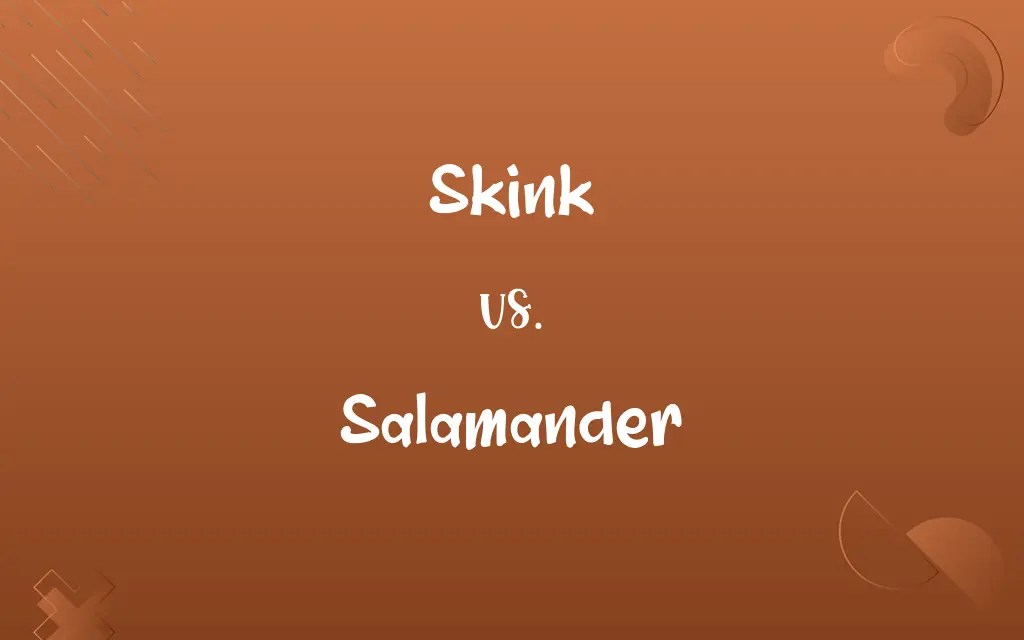Skink vs. Salamander: Know the Difference

By Shumaila Saeed & Hifza Nasir || Published on November 6, 2024
Skinks are a family of lizards known for their smooth scales and elongated bodies, while salamanders are amphibians with moist, permeable skin and a preference for aquatic or damp environments.

Key Differences
Skinks, belonging to the family Scincidae, are characterized by their smooth, shiny scales and a body structure that often appears more streamlined than that of other lizards. They are predominantly terrestrial, though some species can climb or burrow. Whereas salamanders, members of the order Urodela (or Caudata), feature moist, smooth skin and are most commonly found in wet habitats, including streams, ponds, and moist woodlands, due to their amphibious nature requiring them to keep their skin wet for oxygen exchange.
Shumaila Saeed
Nov 06, 2024
Skinks exhibit a wide range of sizes and colors but share common characteristics such as a reduced or absent limb structure in some species, which aids in their burrowing and slinking lifestyle. On the other hand, salamanders have a more uniform body plan with well-developed limbs in most species, enabling them to navigate both aquatic and terrestrial environments effectively.
Shumaila Saeed
Nov 06, 2024
Skinks reproduce in various ways; some species lay eggs, while others give birth to live young, depending on their environment and evolutionary adaptations. In contrast, salamanders have a diverse range of reproductive strategies, including the well-known courtship dances of some species and the laying of eggs in water or on moist land, often guarding them until they hatch.
Shumaila Saeed
Nov 06, 2024
Skinks are adaptable and can be found in a variety of habitats worldwide, from deserts to forests. They primarily feed on insects and other small invertebrates, showcasing their adaptability. Salamanders, however, play crucial roles in their ecosystems as both predators and prey, feeding on insect larvae, worms, and small aquatic organisms, while being sensitive indicators of environmental health due to their permeable skin and complex life cycles.
Shumaila Saeed
Nov 06, 2024
Skinks have evolved sleek bodies and, in some cases, bright warning colors or patterns to deter predators, utilizing speed and concealment for defense. While salamanders rely on their secretive nature, camouflaging colors, and in some cases, toxins secreted from their skin to protect themselves from predators, demonstrating a more passive defense strategy.
Hifza Nasir
Nov 06, 2024
ADVERTISEMENT
Comparison Chart
Habitat
Terrestrial, some arboreal and burrowing
Aquatic or damp environments
Shumaila Saeed
Nov 06, 2024
ADVERTISEMENT
Skink and Salamander Definitions
Skink
Often found in terrestrial habitats.
Skinks are common in gardens, preying on insects.
Dua Fatima
Mar 06, 2024
Salamander
An amphibian with moist skin and a preference for wet habitats.
The spotted salamander thrives in moist, wooded areas.
Shumaila Saeed
Mar 06, 2024
Skink
A lizard with smooth scales and an elongated body.
The blue-tongued skink is known for its distinctive blue tongue.
Shumaila Saeed
Mar 06, 2024
ADVERTISEMENT
Salamander
Known for regenerative abilities.
Salamanders can regrow lost limbs, a focus of scientific research.
Dua Fatima
Mar 06, 2024
Skink
Utilizes speed and hiding for defense.
When threatened, a skink may sprint to the nearest hiding spot.
Shumaila Saeed
Mar 06, 2024
Salamander
Reproduces in water or damp environments.
Many salamanders lay their eggs in vernal pools.
Shumaila Saeed
Mar 06, 2024
Skink
Exhibits a variety of colors and patterns.
Skinks can have bright stripes or spots for warning or camouflage.
Shumaila Saeed
Mar 06, 2024
Salamander
Some species secrete toxins as defense.
The rough-skinned newt secretes a potent toxin to deter predators.
Shumaila Saeed
Mar 06, 2024
Skink
Some species can be viviparous.
Unlike many reptiles, certain skink species give birth to live young.
Dua Fatima
Mar 06, 2024
Salamander
Often has vibrant colors or patterns.
The fire salamander sports bright yellow markings on a black background.
Shumaila Saeed
Mar 06, 2024
Skink
Alert agile lizard with reduced limbs and an elongated body covered with shiny scales; more dependent on moisture than most lizards; found in tropical regions worldwide
Hifza Nasir
Mar 05, 2024
Salamander
Any of various typically terrestrial amphibians that resemble lizards and that return to water only to breed
Shumaila Saeed
Mar 05, 2024
Skink
Any of numerous lizards of the family Scincidae, having a smooth shiny body and large scales on the head, and in some species, small or rudimentary legs.
Shumaila Saeed
Mar 05, 2024
Salamander
Any of various small, tailed amphibians of the order Caudata, having porous scaleless skin and usually two pairs of limbs of equal size, found chiefly in northern temperate regions.
Shumaila Saeed
Mar 05, 2024
Skink
A lizard of the family Scincidae, having small or reduced limbs or none at all and long tails that are regenerated when shed; a sandfish.
Shumaila Saeed
Mar 05, 2024
Repeatedly Asked Queries
What are the primary threats to skinks and salamanders?
Both skinks and salamanders face threats from habitat destruction, pollution, and climate change. Salamanders, in particular, are sensitive to environmental changes due to their permeable skin.
Shumaila Saeed
Nov 06, 2024
Are skinks or salamanders dangerous to humans?
Neither skinks nor salamanders are considered dangerous to humans. While some salamanders secrete toxins that can be harmful if ingested or come into contact with mucous membranes, they are not aggressive and pose little threat when left undisturbed.
Dua Fatima
Nov 06, 2024
What is the significance of a skink's smooth scales?
The smooth scales of a skink help reduce resistance as it moves through its environment, aiding in quick movement and making it harder for predators to grasp.
Hifza Nasir
Nov 06, 2024
How do skinks and salamanders differ in their environments?
Skinks are primarily terrestrial and can inhabit various environments, including deserts and forests, while salamanders require moist or aquatic environments to keep their skin wet for respiration.
Shumaila Saeed
Nov 06, 2024
How do skinks and salamanders reproduce?
Skinks can reproduce either by laying eggs or giving birth to live young, depending on the species. Salamanders typically lay eggs in water or moist environments, with some species exhibiting parental care.
Shumaila Saeed
Nov 06, 2024
Can both skinks and salamanders regenerate lost body parts?
While salamanders are well-known for their ability to regenerate lost limbs, tails, and other body parts, skinks primarily can regenerate their tails, a common defense mechanism against predators.
Hifza Nasir
Nov 06, 2024
How do skinks protect themselves from predators?
Skinks use speed and their ability to hide quickly, along with tail autotomy (detaching their tail) as defense mechanisms.
Dua Fatima
Nov 06, 2024
Why are salamanders important for ecosystems?
Salamanders play vital roles in ecosystems as predators of insect larvae and other small organisms, helping control insect populations, and as prey for larger animals. Their sensitivity to environmental changes also makes them important indicators of ecosystem health.
Shumaila Saeed
Nov 06, 2024
Do salamanders have lungs?
Salamanders have a variety of respiratory strategies ranging from lungs to skin and gill breathing, depending on their lifecycle stage and species.
Shumaila Saeed
Nov 06, 2024
How can you tell a skink from a salamander?
Skinks have dry, scaly skin and are reptiles, while salamanders have moist, smooth skin and are amphibians.
Hifza Nasir
Nov 06, 2024
Can skinks and salamanders be kept as pets?
Both skinks and salamanders can be kept as pets, but they require specific care to mimic their natural habitats, including appropriate humidity, temperature, and diet.
Hifza Nasir
Nov 06, 2024
Share this page
Link for your blog / website
HTML
Link to share via messenger
About Author
Written by
Shumaila SaeedShumaila Saeed, an expert content creator with 6 years of experience, specializes in distilling complex topics into easily digestible comparisons, shining a light on the nuances that both inform and educate readers with clarity and accuracy.
Co-written by
Hifza Nasir








































































